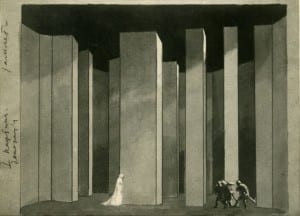Week Four: Scenography & Semiotics
Hi All
This week’s current issue seminar discussion was on Scenography and Semiotics. Now I had some previous understanding on what a scenographer was. In simple terms it is the person who designs the scenery, lighting etc. Something I wish I was good at.
I can design lighting no problem, I feel rather good at it too- but if like Diane (the academic tutor for this week) asked us all to draw and design a set based on the script Death of a Salesman by Arthur Miller.
Sounds easy right?
Oh how wrong was I… I was very wrong. My drawing looked like a three year old had scribbled on the paper for five minutes trying to get as much detail drawn as possible. Let’s put it this way – I’m not going into scenography as a career choice. However this task did help me for creating set ideas for my plays. So I thank you for that DD.
Interpreting the stage visually without anything there can be a real difficult task, yet a stage has limitless opportunities to create some incredible performance space – ideal for performers to move and ascetically pleasing for the audiences’ eyes. “…the stage, regardless of its configuration, functions as an optical focal point and creates the impression that we are looking through this lens into a boundless space beyond” (Aronson, 2005, p. 1).
Word definitions:
Kinesics – is the interpretation of body motion communication such as facial expressions and gestures, nonverbal behaviour related to movement of any part of the body or the body as a whole.
Semiotics – the study of signs and symbols as elements of communicative behaviour; the analysis of systems of communication, as language, gestures, or clothing.
Phenomenology – an approach that concentrates on the study of consciousness and the objects of direct experience.
Metanarrative – a narrative account that experiments with or explores the idea of storytelling, often by drawing attention to its own artificiality.
I will admit all the words above i’d never really heard of them before this class. All I can say it is the words above all link in to the meaning of Drama as we know it.
One person we looked closely at was Edward Gordon Craig, a famous Scenographer set designer who worked closely with the Moscow Theatre Arts. Looking at his work for a production of Hamlet.

Craig’s drawings show in-depth staging, yet I thought of stage space being somewhat smaller in its depth. However his work was designed more with opera styled stages in mind where they have more depth for the sound to travel across the whole space for the audience to hear. Seeing this drawing among others really makes me wish I could draw some amazing sets like Craig but alas that will never happen. I guess i’ll stick to writing plays.
Well my lovelies, until next time.
Bye x
Works Cited:
Aronson, Arnold (2005) Looking into the Abyss: Essays on Scenography, USA: University of Michigan Press. pp. 1 – 80
Craig, E. (1908) Stage Set Design – Hamlet [https://www.pinterest.com/designlifenet/stage-set-design-edward-gordon-craig/]. Pinterest. [accessed 21 October 2016].
Recent Comments